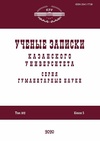Эволюция семитского корня (культурно-исторический аспект)
The Semitic root evolution (cultural and historical aspect)
Author(s): Anatoly E. ZeldinSubject(s): Language studies, Historical Linguistics, Comparative Linguistics, Philosophy of Language, Philology
Published by: Казанский (Приволжский) федеральный университет
Keywords: Semitic root; triconsonantism, Proto-Afroasiatic language; Semitic languages; Natufian culture;
Summary/Abstract: The paper considers the long-ago perceived, but inadequately studied phenomenon of the Semitic root triconsonantism. Some examples of the paradigm realization from the Biblical Hebrew, where the adducing of the third consonant to a 2C-root (biconsonantal) results in the formation of a cluster of the semantically related 3C-roots, are provided. A similar process is noted in other language families that constitute the Afroasiatic phylum. Here it is argued that the phenomenon can be viewed diachronically as a consequence of certain economic, social, and cultural changes during the Natufian period (12 500 – 10 500 BP) in the Near East. Due to the material innovations in agriculture, the Natufians were able to store the agricultural surpluses, and their everyday life became more organized and safer. A hypothesis is made that sociocultural changes during the Paleolithic–Neolithic transition influenced the mundane life of the multiplied and urbanized Natufians, who could now rely on food stocks which allowed them to indulge in idle contacts. These changes led, in turn, to an incentive for spiritual progress and ultimately provided a staging ground for oral lore. The new Neolithic reality demanded novel means of expression that were created by the compounding of 3C-roots (among them, the roots bearing an abstract meaning) from the existing 2C-roots.
Journal: Ученые записки Казанского университета. Серия Гуманитарные науки
- Issue Year: 163/2021
- Issue No: 4-5
- Page Range: 47-66
- Page Count: 20
- Language: Russian

